The following is part of Now Loading, a series that renders verdicts on whether or not your favorite video games deserve a place in the canon of works that have contributed to video-game storytelling in landmark ways. Read the series’ full mission statement here.
Let’s Go to the Mall
JANUARY 3rd
16:00
Ladies and gentlemen, fellow inquisitive minds, hello and welcome to Now Loading…The Video Game Canon! The only Internet column that takes a look at games from the past to determine whether they should be remembered in the future.
Well, folks, I may have gotten myself in too deep on this one. In a meeting with the With a Terrible Fate higher-ups, it was agreed upon that I wasn’t infusing enough field work into this series, and apparently “the numbers” show that people respond to man-in-the-field segments pretty favorably. As I am a man of the people, I have elected to do some hands-on research on today’s Canon candidate, Capcom’s Dead Rising, and so I had to venture out into the world to pick up a copy for myself.
I know what you’re saying, Dear Reader (partly because I’m constructing a strawman of you for the purposes of this question, but also because I can hear your thoughts): “How could you even consider a game for the Canon if you haven’t played it?” Well, my snarky consumer, I never said I didn’t play it, only that I needed a copy of the game.
You see, there was a fallow period in my life during which I only had a handful of games for my XBox 360, and one such game that I poured hours and hours of my adolescent life into was Dead Rising. What this game offered—something that many of its contemporaries did not—was an intense incentive to play it over and over again, giving you new weapons and outfits each time you completed a different achievement in the game and started over. A game you could play over and over again was a veritable everlasting gobstopper to a young man with no pocket money, and so I familiarized myself with every nook and cranny of Willamette Mall, remembered every sarcastic line of dialogue spoken by sassy, over-the-hill protagonist Frank West, mastered every zombie-bashing weapon, and even went so far as to get every achievement in the game, a feat that I had not ever done before, and will likely never repeat.
So trust me, Dear Reader, I am more than familiar with this game and its chilling, black comedy. I just didn’t have a copy of it.
So, here I am, using my need for a physical copy of the game as an excuse to tick the “field-work” box for my bosses. I’m not necessarily sure what would constitute field work for a game about a massive zombie outbreak, but I thought that heading to a mall would be a good place to start. Granted, we’re supposedly in for a huge blizzard here in New England, so maybe it was a bad move to head out into the world and brave the panicked, mall-going public. And it is pretty cold…I mean, sub-zero temperatures for a week.
Nah, I’m thinking about it too much.
That’s all for now, folks. I’ll check in with you once I have the game in hand.
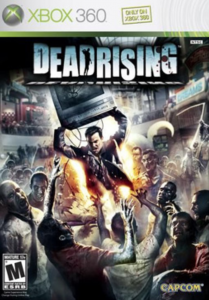
JANUARY 3RD
20:00
The bulk of humanity lays before and behind me.
Dear Reader, there’s nothing quite so hectic as a trip to the mall during a New England snowstorm. Despite living in the thick of winter for the better part of half the year, it’s as if the entire citizenry of the Northeastern U.S. forgets that snow is slippery and ice is dangerous. Fishtailing, fender-bending, and just plain accidents littered the highway as I made my way over here, and now I see that people aren’t faring much better outside of their cars. Everywhere I look, people are ambling shambolically through the mall, lunging out in the food court and in stores for those last-minute purchases before the storm keeps us all locked up for a few days. And talk about rude: some of these people I’ve run into are doing nothing but grunting and moaning as they paw past you. Bunch of degenerates, I tell you.
What’s more, I’ve made it to the video game shop at the west end of the mall, but their security gate is down. I could have sworn that they closed at nine, but maybe they’re preparing for the storm… Ah well, like I said, I can recite this game from memory. It may not be the most journalistically honest thing I’ve ever done, talking about a game having not played it recently, but maybe we can sacrifice some of that integrity for the field work they have me on tonight.
Story and Characters: I’ve Covered Wars, Y’know
Capcom’s 2006 sandbox zombie chop-em-up game, Dead Rising, is the video game medium’s answer to B-grade horror movies. Drawing heavy inspiration from George Romero’s Night of the Living Dead and Dawn of the Dead, Dead Rising partakes in the long tradition of taking a group of people, trapping them in a confined space with endless flesh-eating monsters, and reveling in all forms of social commentary as the blood and gore go flying. In keeping with the myriad of zombie stories that came before it, the game is a tongue-in-cheek commentary on American consumerism in terms of what we buy—and, more important, in terms of what we eat.
We open with our avatar, Frank West, veteran photojournalist and all-around American goon, sneaking into the town of Willamette, Colorado on a helicopter. The National Guard has been called to this sleepy little hamlet, and reports of strange rioting and violence have piqued Ol’ Frankie’s interest such that he wants to spend a few days in town figuring out just what the hell is going on.
Armed only with his receding hairline, snarky attitude, and trusty camera, he’s dropped off on the roof of the Willamette Mall to begin his investigation. After he gathers himself, Frank is greeted by Carlito Keyes, a man who warns the photojournalist that this outbreak of violence is far more than it seems. A bit creeped out, but nevertheless determined, Frank pushes past the mysterious stranger and makes his way through the security room into the mall proper.
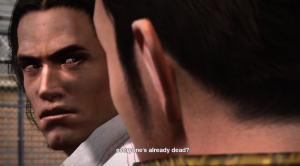
When he bursts onto the scene, he sees a group of survivors in the entrance plaza boarding up the doors as best they can to keep the zombie horde from entering their zone of safety. Frank makes his way to the back of the plaza, only to find a strange old man who starts screaming at Frank, cursing his name that he called him to this damned place.
Naturally, Frank has no idea what the old man is prattling on about; but, before he can further press the issue, we have our first instance of a person completely out of their mind ruining things for everyone else. An old woman screams that she sees her dog outside amidst the zombies, and she rushes past the barricade to open the doors. She is immediately torn apart, and the undead have officially broken into the mall.
What follows is a frantic run back to the security room as name after name flashes red on the screen, indicating that all those people you saw milling around the entrance have been eaten alive and turned into mindless flesh-eaters.

Behold the harbinger of your apocalypse.
The rest of the story is fairly straightforward, and it comes in the form of different case files that Frank embarks on over the course of his three days at the mall. When you make it back to the security room, Otis, a janitor, welds the doorway shut, making this room the only safe place in the mall. Frank meets up with Brad and Jessie, two Department of Homeland Security Agents who are at the mall investigating the zombie incident. As the game progresses and Frank follows up on more cases, we come to find out that the mysterious man on the roof, Carlito, was the one who unleashed the zombie outbreak onto the unsuspecting town of Willamette. We discover that he has a vendetta against the American government—specifically, he is exacting vengeance on one Dr. Barnaby for his cruel experiments that led to the complete destruction of the Central American town of Santa Cabeza.
Dr. Barnaby, the old man who berated Frank in the entrance plaza, was responsible for developing the virus that caused zombism. In an effort to super-breed cows to make more meat for the American public, Dr. Barnaby researched a type of larvae that, despite presenting some promising results when it came to meat production, had the nasty side effect of turning people into horrible, flesh-eating monsters.
You win some, you lose some.

Seems like a nice guy.
So there’s your social commentary, zombie fans. Trying to make more food for our big, American mouths, a crotchety old man created undeath. U.S.A! U.S.A!
After uncovering the truth about the Willamette incident and thwarting Carlito’s plans to unleash even more zombism on the unsuspecting American public, Frank hitches his britches, grabs his camera, and makes for the helipad to be airlifted out of this hellhole. Unfortunately for our boy, the military has been called into the mall with orders to shoot to kill, human and zombie alike.
As such, when a military helicopter sees Frank’s rentable getaway flying towards the epicenter of the outbreak, they naturally shoot him down leaving him with seemingly no escape. As he sees his one way out of this place crash and burn, Frank falls to his knees, and the hope leaves his eyes. A group of zombies shambles towards our crestfallen hero, advancing on him as the credits roll.
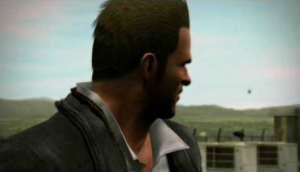
But…but my hair, and…
But not all is lost! That was merely the end of the “72-Hour Mode,” or main story. If you complete all the case files on time and speak to Isabella, Carlito’s turncoat sister, you unlock “Overtime Mode,” which gives you another full day at the mall. This time, however, Frank and Isabella have two things with which to contend: they need to find a way out of the mall without alerting the military, and they have to stave off Frank’s impending metamorphosis into a zombie after his run-in on the roof.
Isabella, having worked alongside Dr. Barnaby in Santa Cabeza, is able to concoct a serum that will keep Frank from turning for a limited time; once that has been taken care of, the pair runs through the underground sewer system through a whole mess of zombies, only to be greeted with a comical, over-the-top fight against the entire military. Frank beats up the special operative, screams into the sky, and the game ends. We are treated with a post-script that lets us know that the story did get out, and that, thankfully, Frank did not descend into the throes of flesh-eating.
At least, not yet.
Now, admittedly, I have rushed through a bit of the plot so that you get a more general idea of the theme this game has to offer: namely, the dangers of consumerism. Naturally, you see the fallout of capitalism with Carlito and his stories of Santa Cabeza, and while that provides a measure of intrigue for the story, what really drives the player through the three days at the mall are the encounters with those living humans who have witnessed raw consumerism and completely lost their minds.
You remember the old woman from the beginning of the game who unleashed hell on the mall to save her dog? She was only the tip of the insane-berg, my friends.
Throughout the course of the 72 hours trapped in the mall, Frank encounters a number of “psychopaths” who are all dealing with the outbreak in their own special way. These encounters are what make Dead Rising stand out amongst other zombie games because they are not only memorably designed, but also legitimately chilling.
Take the first real meeting you have with a psychopath, for example. After you’ve spent a few hours in the mall, you get a call from Otis, the janitor, saying that the roller-coaster ride in one section of the mall has gone completely haywire, and that it’s been running at a much higher speed than usual. When you go to investigate, Frank sees that the level controlling the machine has been pushed all the way up to its highest setting. As he reaches to shut the ride down, a horrifyingly shrill voice tells him to step away from the lever.
When Frank turns around, there stands Adam, the chainsaw juggling clown, telling him not to shut down the ride. If that image wasn’t horrifying enough, Adam then explains that he jacked up the speed of the ride in order to keep the zombies away, because apparently, before he did that, the zombies came and ripped apart all the kids he was entertaining in front of him. For a final cherry on the insanity sundae, Frank gets a glimpse at one of the roller-coaster cars and sees blood-soaked effigies of kids that Adam no doubt thinks he’s protecting. After the battle between Frank and Adam is done, Adam falls on his own chainsaws and laughs gruesomely as his insides are churned into slurry for the approaching zombies.
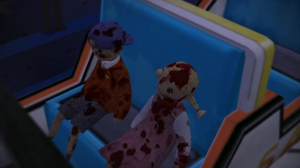
Pictured: A Very Stable Reaction to Trauma
There are a number of other psychopaths, including a grocery-store manager convinced that zombies are stealing from him (because he sees them eating meat all the time), an old Vietnam war vet who starts having Việt-Cộng flashbacks after seeing a group of zombies eat his young granddaughter alive, and a gun-store owner who shoots humans and zombies alike for trying to get their cold, dead hands on his sweet, sweet guns.
What really makes all of these psychopaths legitimately unnerving is that they all either have worked at the mall or were patrons of it. All of them saw consumerism taken to its horrifying, gory conclusion in front of them. Literal consumption of the human commodity can drive man to madness, my friends, and who among us can say we would behave any differently in that situation than a chainsaw-juggling clown?

“I’m a nut!”
JANUARY 3RD
21:00
Well, Dear Reader, after a few moments of urgent banging and clanging, the game-store clerk finally opened up the gate for me. When I told him I had been waiting outside for an hour, he called me crazy and ushered me into the storefront. Crazy? I’d say closing an hour early and then calling one of your customers “crazy” is the real crazy thing, bucko. But hey, the guy seemed nice enough once I was actually in the store and he realized I wasn’t one of “them.” I mulled over this for a minute, but then I noticed the stack of opened PS4s and XBox Ones. I guess he refers to parents who bought the wrong system for their kids as “them”—though you’d think all those returns would have been done before New Year’s…
Ah well, anyway, I found the game, and I bought it from him without incident. Well, with one incident, I suppose: he questioned what the hell I was doing, and just what the hell the meaning of all this was. I realized I had brought him a copy of the original XBox 360 copy of the game, so I guess he must have thought me insane for not buying the HD Xbox One remaster instead. I told him that I was just preferred the classics, and he told me to beat it. This guy’s customer service was so poor that he didn’t even charge me for the game…Whatever, I have enough rewards points that I’m sure he can just deduct some of those in exchange for it.
Some people, am I right?
I must say, Dear Reader, those rude people from earlier have only gotten much handsier since it’s gotten darker. I’m currently sitting in the entrance plaza, because mall security isn’t letting people out of the mall. They seem a bit overqualified for mall security, what with their flak jackets and…assault rifles. But hey, that’s just America in 2018, I guess. The guards won’t speak to me, but, from what I can gather, they’re locking down the mall until the worst part of the storm passes, just because it’s unsafe for people to be outside at the moment. I suppose I understand, but it’s a bit inconvenient, isn’t it?
Ah, well. I’ll just keep writing about Dead Rising in the meantime.
Gameplay, Visuals, and Music: What’s Wrong with Your Face?!
This is always the briefest section of the article, isn’t it, Dear Reader? There’s usually good reason for it, I assure you. As is the case with this article, I have nothing but good things to say about all three criteria listed above when it comes to Dead Rising, so strap in for some fun.
In Dead Rising, the mall is your playground. The game revolves around using anything and everything you find in the gigantic mall as a weapon against the undead horde, and they really make a point of showing you a good time with this feature. You can take the more natural route of using guns, knives, and baseball bats, or you can spend a few in-game hours in the underground parking lot bowling over zombies by the hundreds with a hot-wired sports-car. What’s more, because Frank is a journalist (he’s covered wars, y’know), his camera is an integral and fun part of the gameplay. You’re able to take photos of the crazy ways you kill zombies, psychopaths in compromising positions, and the survivors you bring back to the security room.
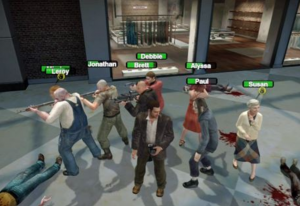
“Lllllllllllladies…and llllllunatics.”
Yes, Dead Rising has quite a few escort missions as part of its main story and optional parts, but they never feel as cloying or annoying as escort missions do in other games. For one thing, you are able to give these survivors weapons with which to defend themselves, so they aren’t all completely useless as you guide them through the zombie horde back to the safe room. Essentially, the game goes out of its way to make everything you do in it fun, and it injects personality into every minor character, set piece, and enemy you come across.
One of the funnier aspects of the game is the music that plays during your excursions through the mall. It has been nearly twelve years since I first played this game, and I can still hum any number of tunes that blast through the mall’s halls as you chop your way through the horde. It’s by no means anything special, but if the goal of the composers was to adequately replicate retail muzak earworms—well then, mission accomplished, boys.
Lastly, what really catches your eye about the visuals in this game is just how god-damned weird every character looks. Not the zombies, mind you: the zombies look just as hideous and grotesque as you’d want them to look. The truly monstrous designs belong to the human characters, who fall directly into that surreal sweet spot we call the uncanny valley.
For the uninitiated, the uncanny valley is a term applied to things that look just a little too human without actually looking human. If you’ve ever seen a robot, or early computer-generated graphics from the nineties, you know what the uncanny valley effect looks like.
Every human character in this game either has bugged-out eyes, weirdly-textured stubble, or malformed jawlines. Take our main man, Frank, for example: with his receding hairline, weird teeth, and buggy eyes, he looks like something straight out of a horror movie. All the survivors, especially the psychopaths, look so strange that they upset the player, adding to the already creepy atmosphere that the game projects.
Limitations are often a boon for video games, and in this case, the weird-looking character designs helped to reinforce Dead Rising’s unsettling tone.

I can’t write anything funnier than this picture.
JANUARY 3RD
22:00
Well, this is getting ridiculous. I thought that the other customers were pushy, but these guards are in a league of their own. They keep asking me “how I got here” and “who I work for,” like they own the place, or something. I tell them I’m just doing field work, and that really sets them off. They’ve grabbed me now and said they’re taking me “somewhere quiet,” so maybe then I’ll have time to play this game.
Impact on Video Gaming and Culture: A B-Movie ‘Till the End
There’s not much to say in terms of this game’s impact, really. Granted, it’s a platinum hit for Xbox, and it generated three full sequels—as well as a few spin-offs and DLC packs—that all saw moderate-to-high success, but you’ll rarely see any of these games on top-one-hundred lists. But I can tell you right now, Dear Reader, you will see it in the Canon, because, to me, this game fills a niche that is sorely lacking in the video-game medium: that of the B-Movie.
See, Dead Rising is a lot like midnight movies from the fifties and sixties that were just meant to be enjoyed by those watching them and turn a profit for those who made them. Sure, the game has some socio-political commentary, but that’s not really why we remember this game. This game is pure, unadulterated horror-fun, and it knows exactly what it is the entire time you’re playing it.
Dead Rising may not be a critical darling, and it’s certainly not high art by any stretch of the imagination. It’s schlock, and our beloved medium needs a healthy dose of well-produced, fun schlock, just like we need pulp fiction, newspaper comics, and B-Movies.
BONUS LEVEL: Time in the Sandbox
Ordinarily in this segment of Now Loading articles, I talk about an underlying theme or specific moment in the game that stands out to me. This time, though, I’m going to move away from this narrative-centric model and instead tell you about the unabashed fun and challenge of “Infinity Mode.”
You see, Dear Reader, once Frank’s story is done and you’ve escaped the horrors of Willamette, you’re able to go back into the mall with no time limit to see just how long you can survive. In this mode, it’s every-man-for-himself with limited resources and a constantly depleting health gauge. You actually have to run around the mall scavenging for food and weapons, sometimes going out of your way to find other survivors so that you can kill them and take their supplies.
I mentioned in the introduction that I have a pretty long history with this game, and I can say with certainty that this game existed in that magical time before DLC, when video game disks had more space than ever and video-game publishers were not yet slicing up video games into various little parts to squeeze money out of the consumer. Shortly after this game came out, game companies (Capcom, especially) began pumping out more and more paid DLC items, shortening the original game in order to get more profit out of it later.
Ironically, Dead Rising, a game about the horrors of unchecked consumerism, was one of the last games Capcom released that offered three full game modes to be played over and over in exciting and fresh new ways for the player.
Ah, well. Thanks for fun times in the sandbox, Capcom.
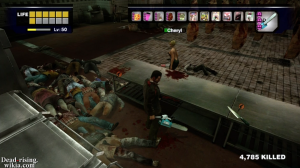
VERDICT: Brains ‘n’ Games
JANUARY 4TH
01:00
A couple of hours and a few blood samples later, and they finally let me go home! It was nice of them to worry about my safety in the blizzard, but when I got out it looked like it hadn’t snowed at all. Well, regardless, I’m finally able to go home and re-play Dead Rising for the first time in nearly a decade. Strange that I didn’t see the rest of those customers leave the mall when they let me out, but hey, maybe there’s meant to be another blast of snow later. Man, am I hungry all of the sudden…
Well, I’ll grab something to eat on the way home. Before I pop the disk into the old 360 and boot it up, I’d like to reiterate that Dead Rising is a charming, fun game with just enough of a haunting atmosphere that it certainly belongs in the Video Game Canon. Or, well, maybe the “B-Canon,” but that’s something we can table for later.
Thanks for reading, folks. I’m going to go get a bite. I’m so itchy, too…must be the cold. Maybe I’ll get some burgers, that’d be tasty. So itchy…tasty…
Itchy tasty.
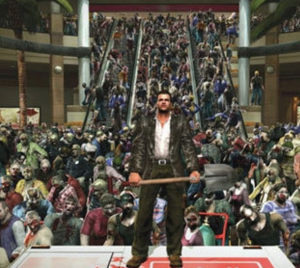
Great job, Frankie!




